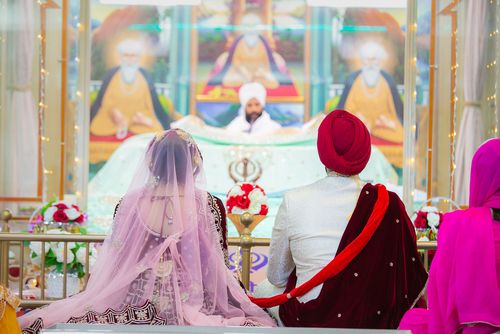 The Anand Karaj is the Sikh wedding ceremony. It typically only involves relatives, as opposed to the reception and other cultural events, which are larger and more elaborate. The ceremony brings about a promise between the couple and the Guru Granth Sahib — the sacred text of Sikhism — that they intend to live as Sikhs throughout their married life.
The Anand Karaj is the Sikh wedding ceremony. It typically only involves relatives, as opposed to the reception and other cultural events, which are larger and more elaborate. The ceremony brings about a promise between the couple and the Guru Granth Sahib — the sacred text of Sikhism — that they intend to live as Sikhs throughout their married life.
Before the Wedding
The Roka and Thaka are ceremonial visits from the bride’s parents to the groom’s home, and the groom’s parents to the bride’s home, to announce their support of the marriage. Kurmai is the engagement ceremony, where the groom presents the bride with a ring, and the bride’s family gifts him with a silver bangle, or kara, and a small ceremonial knife, the kripan.
On the Wedding Day
The Anand Karaj — which means “ceremony of joy” — takes place at the local gurdwara, the Sikh temple. Women in attendance wear long dresses or pants, and men wear long pants. Both are required to cover their head inside the gurdwara. Everyone there sits on the floor throughout the two- to three-hour-long ceremony, so it’s best to wear something comfortable.
Songs from the Guru Granth Sahib are sung, with selections made by the family or members of the congregation. Often, things are planned in advance so that English translations of the songs are available for guests who don’t speak any of the seven Indian languages the Guru is written in.
The Arrival of the Groom and Introduction of Families
The groom’s arrival is called the Baraat, which traditionally happened on horseback. Nowadays, grooms arrive in luxury cars or on motorcycles. The bride’s family meets him outside the gurdwara, teasing gifts and money out of him before letting him inside. This is in keeping with the tradition that the groom must earn his way to the bride.
Next comes the Milni, the introduction of the families of the bride and groom. The bride’s family gives the groom’s family gifts of clothes or cash. The elders meet over a cup of warm masala tea.
From Celebratory to Religious
The ardas, the congregational prayer, moves the ceremony from celebratory to sacred. The couple is put on notice that they are about to make a commitment to each other and to the Guru.
When everyone makes their way inside the gurdwara, the couple sits on the floor beside each other in front of the Guru. Sikh musicians known as Ragis sing and recite each verse of the laavan, the wedding prayers. The couple walks around the Guru four times, signifying the importance of leading a Guru-centric life and promising that they intend to do so. The laavan is the most important part of a Sikh wedding ceremony.
Another major tradition of the Sikh wedding is the Sikhia, where an elder in the community sits in front of the bride and groom, offering them advice on how to live as a religious Sikh couple. This is done to help the couple plan a stable future moving forward as husband and wife. After the Sikhia, the Guru is ceremonially closed.
After the Ceremony
After the closing of the Guru, a vegetarian meal is served to the guests. This meal includes the Roti, signifying the bride’s first meal as a married woman. The groom’s family serves her a platter covered with a cloth. The bride shares her meal with the groom.
A reception is held later, hosted by the groom’s family. They invite the couple’s family and friends to celebrate the new life path the bride and groom are embarking on.
Full of traditional elements, the Anand Karaj is a beautiful ceremony to wed a Sikh couple. Each step along the way has deep meaning and significance to the families and larger community supporting the new bride and groom.